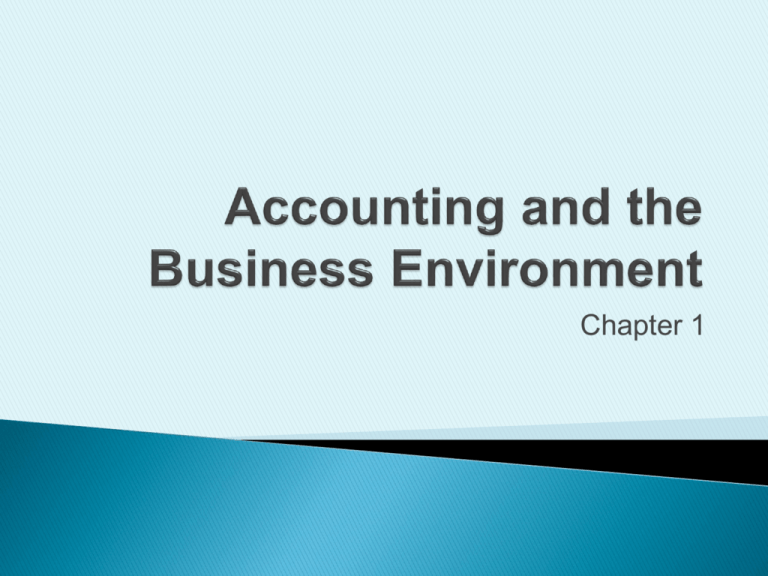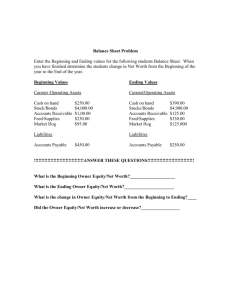
Chapter 1
Define accounting vocabulary
1.
2.
3.
• Measures business activity
• Processes data into reports
• Communicates results to decision
makers
Copyright (c) 2009 Prentice Hall. All rights reserved.
3
End product of accounting process
Report on business in monetary terms
Copyright (c) 2009 Prentice Hall. All rights reserved.
4
Define the users of financial information
Individuals
Businesses
Creditors
Investors
Taxing
Authorities
Copyright (c) 2009 Prentice Hall. All rights reserved.
6
Financial Accounting
Provides information
for external decision
makers
◦ Investors
◦ Creditors
◦ Taxing authorities
Managerial Accounting
Provides information
for internal decision
makers
◦ Managers
◦ Individual business
owners
Copyright (c) 2009 Prentice Hall. All rights reserved.
7
Describe the accounting profession and the
organizations that govern it
Lucrative career with many opportunities
Certified Public Accountants (CPAs)
◦ Pass qualifying exam
◦ Meet education and/or experience requirements
Public Accounting –
CPA Firms
Private Accounting –
Business & Other
Organizations
Copyright (c) 2009 Prentice Hall. All rights reserved.
9
FASB
• Financial Accounting Standards Board
• Private organization that makes accounting
standards
SEC
• Securities & Exchange Commission
• Government agency that regulates the stock
markets
AICPA
IMA
• American Institute of CPAs
• Private organization of public accountants
• Institute of Management Accountants
• Organization of private accountants
Copyright (c) 2009 Prentice Hall. All rights reserved.
10
Investors &
creditors want
reliable financial
information
Companies want to
attract investors
Copyright (c) 2009 Prentice Hall. All rights reserved.
11
SEC requires companies to have financial
statements examined by CPAs
◦ Auditors will provide an opinion on financial statements, if
possible
Recent accounting scandals hurt investor
confidence
◦ U.S. Government passed the Sarbanes-Oxley Act (SOX)
Criminal offense to falsify financial statements
◦ Also created the Public Companies Accounting Oversight
Board
Watchdog of accounting profession
Copyright (c) 2009 Prentice Hall. All rights reserved.
12
AICPA
IMA
Code of
Professional
Conduct
Standards of
Ethical
Conduct
Guides CPAS
in their work
Sets
standards for
private
accountants
Copyright (c) 2009 Prentice Hall. All rights reserved.
13
Identify the different types of business
organizations
Proprietorships
Partnerships
Corporations
Limited
Liability
Companies
Copyright (c) 2009 Prentice Hall. All rights reserved.
15
Proprietorship Partnership
Corporation
LLC
Owners
One
Two or more
Stockholders –
usually many
Members
Life of
Organization
Limited by
owner’s choice
or death
Limited by
owner’s choice
or death
Indefinite
Indefinite
Liability of
owners for
business
debts
Owner is
personally
liable
Partners are
personally
liable
Stockholders
not personally
liable
Members
are not
personally
liable
Copyright (c) 2009 Prentice Hall. All rights reserved.
16
Delineate the distinguishing characteristics and
organization of a proprietorship
Separate Legal Entity
• Distinct from owners
No Continuous Life
• The life of business is limited by the owner’s choice or
the owner’s death
Unlimited Liability of Owner
• Owner has unlimited liability for the business’s debts
Copyright (c) 2009 Prentice Hall. All rights reserved.
18
Unification of Ownership and Management
• Owners not responsible for corporate debts
Business Taxation
• Not a separate taxable entity
• Income flows directly to the sole owner’s tax return,
where he or she pays self- employment and income tax
Government Regulation
• Minimal regulation is an advantage
Copyright (c) 2009 Prentice Hall. All rights reserved.
19
Incorporators obtain charter from the state
Charter authorizes corporation to:
◦ Issue stock
◦ Conduct business in accordance with state law and the
corporation’s bylaws
Corporations begins to exist when stock is issued
◦ Stockholders vote on who will serve on Board of
Directors
Copyright (c) 2009 Prentice Hall. All rights reserved.
20
Stockholders elect
Board of Directors who hire
Officers of the corporation
Copyright (c) 2009 Prentice Hall. All rights reserved.
21
Apply accounting concepts and principles
Generally Accepted Accounting Principles
◦ Rules that govern accounting
◦ Based on a conceptual framework
Goal:
◦ To provide useful information to those making investment
and lending decisions
Copyright (c) 2009 Prentice Hall. All rights reserved.
23
Entity
Concept
Reliability
Going
Concern
Cost
Monetary
Unit
Copyright (c) 2009 Prentice Hall. All rights reserved.
24
Entity Concept
• A business is separate from its owners
Reliability
• Accounting information is accurate and free from
bias
Cost
• Assets are recorded at purchase price
Copyright (c) 2009 Prentice Hall. All rights reserved.
25
Going concern
• Assumption that business will continue
indefinitely
Monetary Unit
• In the U.S. amounts are recorded in dollars
• The dollar is considered a stable unit of
measure
Copyright (c) 2009 Prentice Hall. All rights reserved.
26
Define and use the accounting equation
Assets =
Economic
Resources
Liabilities + Owner’s equity
Claims to
Economic
Resources
Copyright (c) 2009 Prentice Hall. All rights reserved.
28
Economic resources that have a future benefit
Examples:
◦
◦
◦
◦
◦
Cash
Accounts receivable
Merchandise inventory
Furniture
Land
Copyright (c) 2009 Prentice Hall. All rights reserved.
29
Liabilities
◦ Debts payable to
outsiders
◦ Examples:
Accounts payable
Bank loans
Owners’ equity
◦ Owners’ claims to the
assets of the business
◦ In a proprietorship
owner’s equity
Copyright (c) 2009 Prentice Hall. All rights reserved.
30
Assets =
Liabilities + Owner’s equity
Copyright (c) 2009 Prentice Hall. All rights reserved.
31
Capital
Revenues
+ Net income
- Expenses
- Withdrawals
Copyright (c) 2009 Prentice Hall. All rights reserved.
32
Amounts earned by delivering goods or services
to customers
◦
◦
◦
◦
Sales revenue
Service revenue
Interest revenue
Dividend revenue
Copyright (c) 2009 Prentice Hall. All rights reserved.
33
Outflows of assets or increasing liabilities in the
course of delivering goods or services to
customers
◦
◦
◦
◦
Salary expense
Rent expense
Utilities expense
Interest expense
Copyright (c) 2009 Prentice Hall. All rights reserved.
34
Assets
Nice Cuts
$??
Love Dry
Cleaners
85,000
Hudson Gift
and Cards
102,000
Liabilities
$25,000
??
49,000
Owner’s
equity
$43,000
54,000
??
35
Assets
Nice Cuts
Love Dry
Cleaners
Hudson Gift
and Cards
Liabilities
Owner’s
equity
$?
$68,000
$25,000
$43,000
85,000
?
31,000
54,000
102,000
49,000
?
53,000
36
Depict accounting for business transactions
An event that affects the financial position of a
particular entity
Can be recorded reliably
Every transaction impacts at least two items
The accounting equation balances before and
after each transaction
Copyright (c) 2009 Prentice Hall. All rights reserved.
38
Assets
Liabilities
Accounts
Accounts
Date Cash receivable Supplies Land payable
Bal
2,500
1,500
Assets = $17,000
0 13,000
4,000
Owner’s Equity
Marilyn Mansion,
Capital
13,000
Liabilities & Equity =
$17,000
Copyright (c) 2009 Prentice Hall. All rights reserved.
39
Date Cash
Bal
2,500
(a)
10,000
Bal
12,500
Assets
Accounts
receivable Supplies
1,500
-
Land
Liabilities
Accounts
payable
Owner’s Equity
Marilyn Mansion,
Capital
13,000
4,000
13,000
10,000
1,500
Assets = $27,000
-
13,000
4,000
23,000
Liabilities & Equity =
$27,000
Copyright (c) 2009 Prentice Hall. All rights reserved.
40
Assets
Liabilities
Accounts
Accounts
Date Cash receivable Supplies Land payable
Owner‘s Equity
Marilyn Mansion,
Capital
Bal
(b)
12,500
1,100
1,500
- 13,000
4,000
23,000
1,100
Bal
13,600
1,500
- 13,000
4,000
24,100
Assets = $28,100
Liabilities & Equity =
$28,100
Copyright (c) 2009 Prentice Hall. All rights reserved.
41
Accounts
receivable
Date
Cash
Bal
13,600
(c)
(4,000)
Bal
9,600
Supplies
1,500
-
Land
13,000
Accounts
payable
Marilyn Mansion,
Capital
4,000
24,100
(4,000)
1,500
Assets = $24,100
-
13,000
0
24,100
Liabilities & Equity =
$24,100
Copyright (c) 2009 Prentice Hall. All rights reserved.
42
Date
Bal
Cash
9,600
Accounts
receivable Supplies
1,500
(d)
Bal
Land
-
1,500
Assets = $24,800
700
Marilyn Mansion,
Capital
13,000
700
9,600
Accounts
payable
24,100
700
13,000
700
24,100
Liabilities & Equity =
$24,800
Copyright (c) 2009 Prentice Hall. All rights reserved.
43
Date
Accounts
receivable Supplies
Cash
Bal
9,600
1,500
(e)
600
(600)
Bal
10,200
900
Assets = $24,800
Accounts
payable
Land
Marilyn Mansion,
Capital
700
13,000
700
24,100
700
13,000
700
24,100
Liabilities & Equity =
$24,800
Copyright (c) 2009 Prentice Hall. All rights reserved.
44
Date
Cash
Bal
10,200
(f)
1,700
Bal
11,900
Accounts
receivable Supplies
900
700
Land
13,000
Accounts
payable
Marilyn Mansion,
Capital
700
24,100
1,700
900
Assets = $26,500
700
13,000
700
25,800
Liabilities & Equity =
$26,500
Copyright (c) 2009 Prentice Hall. All rights reserved.
45
Date
Cash
Bal
11,900
(g)
Bal
Accounts
receivable Supplies
900
700
Land
13,000
Accounts
payable
Marilyn Mansion,
Capital
700
4,300
11,900
5,200
Assets = $30,800
25,800
4,300
700
13,000
700
30,100
Liabilities & Equity =
$30,800
Copyright (c) 2009 Prentice Hall. All rights reserved.
46
Date
Cash
Bal
11,900
(h)
(1,000)
Accounts
receivable Supplies
5,200
700
Land
13,000
Accounts
payable
Marilyn Mansion,
Capital
700
(1,000)
(300)
Bal
10,600
30,100
(300)
5,200
Assets = $29,500
700
13,000
700
28,800
Liabilities & Equity =
$29,500
Copyright (c) 2009 Prentice Hall. All rights reserved.
47
Date
Cash
Bal
10,600
(i)
Bal
Accounts
receivable Supplies
5,200
100
10,700
700
Land
Accounts Marilyn Mansion,
payable
Capital
13,000
700
28,800
13,000
700
28,800
(100)
5,200
Assets = $29,500
600
Liabilities & Equity =
$29,500
Copyright (c) 2009 Prentice Hall. All rights reserved.
48
Date
Cash
Accounts
receivable
Supplies
Land
Accounts Marilyn Mansion,
payable
Capital
Bal
(j)
10,700
(2,200)
5,200
600 13,000
700
28,800
(2,200)
Bal
8,500
5,200
600 13,000
700
26,600
Assets = $27,300
Liabilities & Equity =
$27,300
Copyright (c) 2009 Prentice Hall. All rights reserved.
49
Explain and prepare financial statements
Income
Statement
Balance
Sheet
Statement
of Owner’s
Equity
Statement
of Cash
Flows
Copyright (c) 2009 Prentice Hall. All rights reserved.
51
Reports on profitability of business
Revenues
Expenses
minus
equals
Net income
If expenses >
revenue = net
loss
Copyright (c) 2009 Prentice Hall. All rights reserved.
52
Summary of changes in owner’s capital during a
specific period
Beginning Capital
Plus: Net income (or minus net loss)
Less: Withdrawals
Equals: Ending Capital
Copyright (c) 2009 Prentice Hall. All rights reserved.
53
Reports the entity’s assets, liabilities, and owner’s
equity as of a specific date
Balance
Assets
Sheet
Liabilities
Equity
Copyright (c) 2009 Prentice Hall. All rights reserved.
54
Reports cash receipts and cash payments during
a period
Copyright (c) 2009 Prentice Hall. All rights reserved.
55
Goth Inc.
Income Statement
Month ended September 30, 2011
Revenue:
Service revenue
$5,400
Expenses:
Rent expense
Advertising expense
Total expenses
Net income
$1,000
300
1,300
$4,100
Copyright (c) 2009 Prentice Hall. All rights reserved.
56
Goth Inc.
Statement of Owner's Equity
Month ended September 30, 2011
Marilyn Mansion, Capital, September 1, 2011
Add: Investments by owner
Net income
$13,000
11,700
4,100
$ 28,800
Less: Withdrawals
(2,200)
Marilyn Mansion, Capital, September 30, 2011 $ 26,600
Copyright (c) 2009 Prentice Hall. All rights reserved.
57
Goth Inc.
Balance Sheet
September 30, 2011
Assets
Cash
Accounts receivable
Supplies
Liabilities
$8,500 Accounts payable
$ 700
5,200
600
Owner’s Equity
Land
13,000 Marilyn Mansion, Capital
26,600
Total assets
27,300 Total liabilities & owner’s equity
27,300
Copyright (c) 2009 Prentice Hall. All rights reserved.
58
Use financial statements to evaluate business
performance
Income Statement
Revenues - Expenses
=
Net Income
Statement of Owner’s Equity
Increased by Net Income
Decreased by Withdrawals
Balance Sheet
Assets
=
Liabilities + Equity
Copyright (c) 2009 Prentice Hall. All rights reserved.
60
Income
Statement
Statement of
Owner’s Equity
Balance Sheet
Demonstrates
profitability
Shows
changes in
Capital
Displays
financial
position
Copyright (c) 2009 Prentice Hall. All rights reserved.
61








